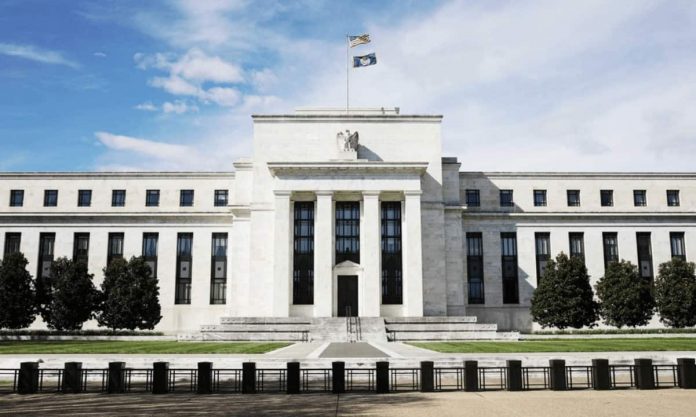The Federal Reserve has released a comprehensive working paper delving into asset tokenization and Risk-Weighted Assets (RWA). As the financial landscape continues to evolve, these innovative financial instruments garner significant attention for their potential to revolutionize investment strategies and reshape traditional markets.
The paper explains that tokenization, similar to stablecoins, consists of five core components: a blockchain, a reference asset, a valuation mechanism, storage or custody, and redemption mechanisms. These elements establish connections between crypto markets and reference assets, enhancing understanding of their impact on conventional financial systems.
Tokenized Assets Have Been Surging
According to the paper, the estimated market value of tokenized assets on permissionless blockchains stands at an impressive $2.15 billion as of May 2023. This valuation encompasses tokens issued by decentralized protocols like Centrifuge and established companies such as Paxos Trust.
The variability in tokenization designs and levels of transparency poses a challenge in obtaining comprehensive time-series data. Nevertheless, insights from DeFi Llama data highlight a burgeoning trend in tokenization within the DeFi ecosystem.
While the total value locked (TVL) in the DeFi ecosystem has remained relatively stable since June 2022, categories related to real-world assets have grown, both in absolute value and as a proportion of the overall DeFi ecosystem. Of the estimated $2.15 billion in tokenized assets, approximately $700 million is currently locked in DeFi.
The paper explains that asset tokenization offers access to previously inaccessible or costly markets, such as real estate, where investors can acquire shares in specific properties. Its programmable nature and smart contract capabilities allow liquidity-saving mechanisms in settlement processes, enhancing efficiency.
Tokenizations also facilitate lending using tokens as collateral, providing a new financing avenue. Transactions involving tokenized assets settle more swiftly than traditional reference assets, potentially revolutionizing settlement processes in the financial industry.
The Issue of Financial Stability
Despite tokenization’s promise, there are notable considerations regarding financial stability. While tokenized markets’ current value remains relatively small compared to broader financial systems, the potential for growth raises concerns about fragility within crypto-asset markets and implications for the traditional financial system.
The primary long-term concern centers around the interconnections between the digital asset ecosystem and the traditional financial system through tokenization redemption mechanisms. In instances where reference assets lack liquidity, stress transmission vulnerabilities may arise. This risk mirrors concerns raised in the ETF market, where the paper explains that liquidity, price discovery, and volatility of ETFs closely align with their underlying assets.
As tokenization expands, traditional financial institutions may become increasingly exposed to crypto-asset markets through direct ownership or collateralization. This shift introduces new dynamics and interconnections, potentially influencing market behaviors in unforeseen ways.
Binance Free $100 (Exclusive): Use this link to register and receive $100 free and 10% off fees on Binance Futures first month (terms).
PrimeXBT Special Offer: Use this link to register & enter CRYPTOPOTATO50 code to receive up to $7,000 on your deposits.
Credit: Source link






















 Bitcoin
Bitcoin  Ethereum
Ethereum  Tether
Tether  Solana
Solana  USDC
USDC  Lido Staked Ether
Lido Staked Ether  XRP
XRP  Dogecoin
Dogecoin  Toncoin
Toncoin  Cardano
Cardano  Shiba Inu
Shiba Inu  Avalanche
Avalanche  TRON
TRON  Wrapped Bitcoin
Wrapped Bitcoin  Bitcoin Cash
Bitcoin Cash  Polkadot
Polkadot  Chainlink
Chainlink  NEAR Protocol
NEAR Protocol  Polygon
Polygon  Internet Computer
Internet Computer  Litecoin
Litecoin  Uniswap
Uniswap  LEO Token
LEO Token  Dai
Dai  First Digital USD
First Digital USD  Ethereum Classic
Ethereum Classic  Aptos
Aptos  Hedera
Hedera  Stacks
Stacks  Cronos
Cronos  Mantle
Mantle  Stellar
Stellar  Cosmos Hub
Cosmos Hub  Filecoin
Filecoin  Renzo Restaked ETH
Renzo Restaked ETH  XT.com
XT.com  OKB
OKB  Pepe
Pepe  Render
Render  Immutable
Immutable  Arbitrum
Arbitrum  Bittensor
Bittensor  Wrapped eETH
Wrapped eETH  dogwifhat
dogwifhat  Maker
Maker  Optimism
Optimism  The Graph
The Graph 
